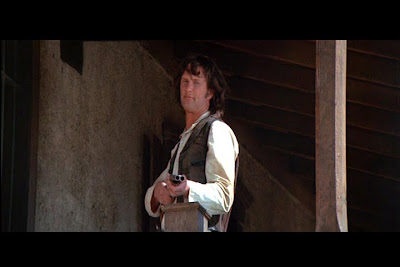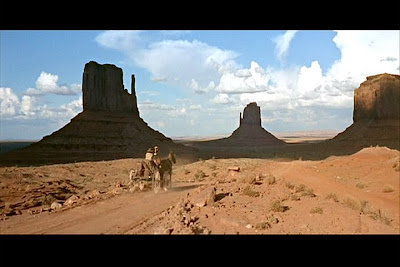 Released: December 12, 1974 (NYC Premiere)
Released: December 12, 1974 (NYC Premiere)Director: Francis Ford Coppola; Screenplay: Mario Puzo and Francis Ford Coppola, based partially on the novel by Mario Puzo; Cinematography: Gordon Willis; Studio: Paramount Pictures; Producer: Francis Ford Coppola, with co-producers Gary Frederickson and Fred Roos
Cast: Al Pacino (Don Michael Corleone), Robert Duvall (Tom Hagen), Robert De Niro (Young Vito Corleone), Diane Keaton (Kay Corleone), John Cazale (Fredo Corleone), Talia Shire (Connie Corleone), Lee Strasberg (Hyman Roth), Michael V. Gazzo (Frankie “Five Angels” Pentangali), Morgana King (Mama Carmella Corleone), G.D. Spradlin (Senator Pat Geary), Richard Bright (Al Neri), Gastone Moschin (Don Fanucci), Dominic Chianese (Johnny Ola), B. Kirby Jr. (Young Pete Clemenza), Frank Sivero (Young Ginco Abbandando), Joe Spinell (Willie Cici), Tom Rosqui (Rocco Lampone)
- “Keep your friends close, but your enemies closer.”
Let’s just start with the two most obvious questions to emerge with this selection. Was it as easy to envision as the sun rising in the east? My guess, knowing how in tune with my tastes many of you are, is yes. Never being one to shy away from populist picks, it really was a no-brainer for me. Plus, I in turn would be willing to bet that a lot of folks reading the blog will pick this one as their #1 for 1974 as well, or at the very least give it strong consideration. The second question would be this: is the sequel better than the original? My short answer is no, it’s close, but even that might change by the time I address the question more fully later in this write-up!
The staggering thing about how easy it is to pick The Godfather Part II for 1974 is that it masks what an incredible year in film this was – particularly for Francis Ford Coppola. There are a number of films released in this year that would have contended in any year in this countdown. Aside from this legendary middle entry in The Godfather trilogy, Coppola also released the equally superb The Conversation, which riffs on (and in my opinion improves upon) the template used by Antonioni in Blow-Up. Also released in this year was Roman Polanski’s most celebrated film in the neo-noir thriller Chinatown. And the list goes on. R.W. Fassbinder put out Ali: Fear Eats the Soul. Martin Scorsese went to Hollywood and made the underrated Alice Doesn’t Live Here Anymore. Jacques Rivette, who I have very little experience with, released the outstanding Celine and Julie Go Boating. In short, this was a huge, top-heavy year.
And yet, there was absolutely zero drama in making this pick. No second-guessing, no double-take, no hesitation. The movie is that magnificent. For me, there are few films in the history of cinema that could have unseated it from the top spot.

It follows the continuing saga of the Corleone family, as the new leader Michael (Al Pacino) tries to move the family business into more legitimate interests in Nevada and elsewhere around the globe. To do this, he begins to work closely with his father’s longtime associate Hyman Roth (Lee Strasberg), who steers Michael into business deals in pre-Castro Cuba. Unfortunately for the gangsters looking to capitalize on gambling on the island, Castro is near taking power and nationalizing all of their business interests. Along the way, various plots and counterplots are hitched, as Michael tries to protect his high-level business interests abroad while at the same time mediating street-level disputes back in New York. Being pulled from every direction, in addition to having to endure Senate hearings into organized crime, Michael scrambles to maintain control.

The other unique aspect of Part II is that it simultaneously tells the story of Vito Corleone’s (Robert De Niro) rise from orphaned Sicilian immigrant to kingpin of the entire New York underworld. We see him flee from Mafia leaders trying to kill him in Sicily, travel as a young boy through Ellis Island, and then try to make a life for himself in this strange country. Much like his son Michael would years later, Vito enters a life of crime very reluctantly. It is by a chance favor he does for the young Pete Clemenza (B. Kirby, Jr.) that he realizes that he can make a way in the world through such means. After he kills Don Fannuci, the neighborhood boss, and takes over the rackets, he then begins to emerge into The Godfather that Marlon Brando portrays so brilliantly in the first film. It is amazing to see both the similarities and contrasts that can be drawn between Vito and Michael. They are the same in that they both grudgingly became crime leaders, but the differences in their situations are striking. For Vito, becoming a crime boss was his one way up and out of the ghetto. Michael, by contrast, is realizing that being a Mafia boss at this time makes him an anachronism. While Vito emerged as a respected neighborhood hero, Michael is the target of everyone from the authorities, to rivals, to even family members.
The thing that makes Part II so fresh and able to stand on its own – despite the fact that it follows essentially the same path as the original – is the addition of the new characters and cast members. Lee Strasberg as Hyman Roth is simply amazing. Strasberg was already a legend in the worlds of acting and theater, becoming director of the Actors Studio in 1951. He was an advocate of what is now commonly known as “method acting,” and would teach this craft to a variety of stars. The list of those that studied under him is staggering: Marlon Brando, James Dean, Paul Newman, Montgomery Clift, Marilyn Monroe and, most importantly in regards to this review, Al Pacino. Pacino and Coppola convinced Strasberg to make his on-screen debut as Hyman Roth, a character based on legendary Jewish gangster Meyer Lansky. The parallels between Roth and Lansky are quite obvious – Jewish gangster who teams up with a rising Italian gang leader, the headquarter move to Miami, financing casinos in Havana, the “we’re bigger than US Steel” quote are all straight from the life of Lansky. And this also allows me to repeat one of my favorite stories concerning Strasberg and his performance. It’s a legend of sorts, and one that I don’t know is completely accurate, but according Strasberg’s widow, shortly after the film was released he received a mysterious phone call. Although the man did not give his name, it supposedly was Meyer Lansky himself, who told Lee “You did good.” Lansky also wondered, “Why couldn’t you make me more sympathetic?”

I eat up such legends and tall tales like this, so I had to include it. Is it true? I have no idea, but I don’t know why Anna Strasberg would make it up – let’s hope she was either telling the truth or just embellishing, so it doesn’t ruin it for me! But even if only apocryphal, it’s interesting. Strasberg’s performance is that good. He makes Hyman Roth a lovable grandfatherly character when sitting in his Florida home watching football on a Saturday afternoon, but a tenacious businessman when dealing with associates and rivals in the underworld. The speech delivered at the hotel in Havana about “this is the life we chose” is probably my favorite monologue in all of cinema. It still has the power to give me goosebumps. Strasberg was nominated for an Academy Award for Best Supporting Actor, but unfortunately did not win.
Who, you might ask (as if you didn’t already know), possibly could have been honored over Strasberg? Fellow cast-mate Robert De Niro. This is not the brash, in-your-face De Niro that made him famous as Johnny Boy in Scorsese’s Mean Streets or would become his signature in roles such as Jimmy Conway in Goodfellas. As the young Vito Corleone, he is calculating, contemplative, at times even timid. What is interesting is watching as Vito overcomes his trepidation in this new world and grows into the man that would dominate an entire city. If I wanted to be argumentative, I could squabble and say that I slightly prefer Strasberg’s performance, but that is splitting hairs. They’re both superb.
To a lesser degree, it is also necessary to point out that Frank Pentangali (Michael V. Gazzo), with his loyal minion Willie Cici (Joe Spinell), also adds much to the film. A character such as this was vital to add the element of Michael being pulled back into the streets, so to speak, as it shows the complete futility of his trying to move his family away from New York. In addition, Frankie Five Angels in general is just an entertaining character, adding not only drama but many lighthearted moments.
Yet with all of these brilliant additions, it can be argued that the film is still carried on the strength of those characters returning from the first film. While it might have been in doubt in Part I, in this sequel Michael is unquestionably the main character. Gone is the idealistic war hero that walks into the Corleone compound at the beginning of the first film. Michael now has become ruthless, a man blinded by his greed and aspirations. He continues to lie to both Kay and himself that the Corleone family will be legit in a few short years, but all the time working with the same shadowy methods that made his family so powerful. Tom Hagen (Robert Duvall), always one of my favorite characters in the entire saga, emerges as the rock of the Corleones. The man is steady in the face of every storm the family faces. And then there is Fredo, the black sheep of the family played to perfection by John Cazale. His murder scene, with Michael standing alone at a window, is the most haunting image in any of the three movies.

At the beginning of this piece I posed the question of whether this is better than the first film. Traditionally, I say no. But in all honesty, this entire series has reached the point where it’s silly for me to even separate them into parts. Watching the entire progression from the rise of the Corleone empire to the destruction of Michael Corleone is American storytelling at its best.
And, just as an addendum, I would submit the final scene of this film as among the finest in the entire series. It is a flashback to December 7, 1941, the Don’s birthday, and the family is sitting around the table waiting for Don Corleone to arrive for his surprise party. Everyone is there – Sonny, Fredo, Tom, Connie, Carlo, Tessio. Everyone is laughing and having a good time. Then Michael drops a bomb, announcing that he has enlisted in the Marines. It is Michael flashing back to his idealistic days and it is a perfect cap to arguably a perfect film.
Rating: 10/10
Other Contenders for 1974: I basically went ahead and ran through my other favorites of this year. So, I’ll just go ahead and list them in rough order of preference. It’s also amazing to think that both of my top two films for the year are directed by Coppola. If he waits a year to release either of them, I can guarantee that it would have been my top movie of 1975.
- The Conversation (Coppola)
- Chinatown (Polanski)
- Ali: Fear Eats the Soul (Fassbinder)
- Alice Doesn’t Live Here Anymore (Scorsese)
- California Split (Altman)
- Celine and Julie Go Boating (Rivette)





























